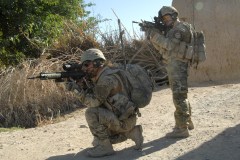Lawyers are not a popular breed, especially when they are perceived to be chasing ambulances. But in some cases they can actually help, although not always in the way you might expect.
Take, for example, an incident in which six British soldiers died when their outpost at Al Majarr Al Kabir, in Maysan province of Iraq was overrun by local tribesmen. It sounds like an  event from Britain’s colonial past but in fact it took place on 24 June 2003.
event from Britain’s colonial past but in fact it took place on 24 June 2003.
The subsequent Board of Inquiry conducted its work thoroughly and “found that the incident at Al Majarr Al Kabir was a surprise attack, which could not reasonably have been predicted”.
The inquest in 2006 recorded a verdict of unlawful killing. The British Army learnt and implemented its lessons. The six soldiers were remembered along with the other 173 British deaths in Iraq between 2003-2009, during what was known as Operation TELIC.
That was it, until 31 July 2013 when Sky News announced “Murdered Red Cap’s Family To Sue Government”.
Following the landmark judgement from the Supreme Court in June, which ruled that soldiers at war in foreign lands were covered by human rights laws and therefore owed a duty of care, the family of Corporal Russell Aston is suing the British Government for negligence.
The lawyers will no doubt be looking forward to this. For some it will be the crusading instinct of testing their skill against the boundaries of the law. Others will be salivating at the thought of all the potential “no win, no fee” work ready to be scooped from past and future conflict. All will be anticipating some healthy fees. However, lawyers aside, what good will come of this legal action?
Will the family benefit? I doubt that the court case will provide much comfort to them, despite the £250,000 sum that Sky News is quoting in compensation. I don’t believe that it’s about the money.
The adversarial nature of the court means that it will be win or lose and the stakes are high for the Ministry of Defence (MOD). Losing will perpetuate the family’s anguish and winning will come at a price. I have never met anyone who has found tribunals or litigation less than traumatic, even if they end up on the winning side.
The best solution for the family would have been to resolve the conflict through mediation. This private, informal, consensual approach would almost certainly have delivered the answers needed by the family.
Sadly, it’s probably too late now, but if they were to change their minds North Light Solutions would support them.
The Corporate Manslaughter and Corporate Homicide Act 2007 focussed the Army on unacceptable deaths under the Health and Safety umbrella . It forced commanders to take legal responsibilities for equipment and training through a system of competent army authorities. It became incumbent on all the Armed Services to make sure that individuals were properly prepared for operations and that equipment was fit for purpose.
If such an authority had been in place in 2003 it is probable that failings such as the lack of body armour, highlighted at the inquest of Sergeant Steven Roberts, who was killed by friendly fire in March 2003, would never have occurred.So a legally defined duty of care for soldiers on the battlefield should be a good thing. No more half measures, just proper support.
The MOD will be concerned that the legal action will result in an outflow of cash in damaging legal actions. Army commanders will be concerned that additional legislation would limit their freedom of action in operational theatres. And yet maybe that would not be such a bad thing.
The Army’s operation in Iraq was not the British Army’s finest hour, despite the best efforts of the youngsters on the ground.
British operations were shown to be under-resourced and under-committed. The withdrawal of troops from Iraq in 2003 to garrison a peaceful Northern Ireland, just as the insurgency broke out in Southern Iraq, seems to me to have been a significant misjudgement.
The British Army showed none of the agility of the US forces who, once they realised they had got it wrong, were able to write the doctrine, design and procure the equipment and retain the force while our soldiers were still trundling round in the ill suited SNATCH Land Rovers.
A successful action will force the Army and the MOD, in particular, to look more carefully at resourcing operations. The political cap on manpower will have to match the task. No more “just enough, just in time” logistics that turn into “too little, too late.”
Military priorities will have to be reviewed as new operations emerge. Allies will have to be asked about their intent; no more mates going to a party but business partners working together over clearly defined aims. The decision makers – politicians, civil servants and senior officers – will have to be accountable.
Nobody would be naive enough to believe that the risk could be taken out of military operations but we should all subscribe to the belief that if we are going to do it, we must do it right.
So will any good come from this action? As I said earlier, the family will find it devastating and I sincerely wish they would take the less adversarial course of mediation to meet their needs.
For the rest, I think it could be a catalyst for positive change and I will raise a glass if the family wins.









